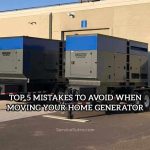Power outages can strike with little warning, whether due to severe storms, ageing infrastructure, or unexpected grid failures. For homeowners, this makes preparation essential. An effective strategy begins with a generator and understanding your options. This home generator guide, standby portable comparison offers an in-depth look at choosing, maintaining, and utilizing generators as part of a comprehensive emergency plan.
Understanding Generator Types
Choosing the right generator starts with knowing what options are available. Generators typically fall into two categories: standby and portable. Each has benefits and drawbacks depending on your home layout, energy needs, and budget.
Standby Generators
Standby generators are permanently installed systems connected directly to your home’s electrical panel. They automatically activate during an outage, providing a seamless transition to backup power. Fueled by natural gas or propane, they can power an entire home or essential systems like HVAC units, refrigerators, and sump pumps.
Portable Generators
Portable generators are more affordable and mobile, offering a flexible solution for temporary outages. They run on gasoline or diesel and require manual startup and connection through extension cords or a transfer switch. These are best suited for powering a few critical appliances rather than the entire household.
Generator Selection Factors
When deciding between standby and portable options, several key factors should influence your choice:
- Budget: Portable generators range from $400 to $2,500, while standby units typically cost between $5,000 and $15,000, including installation.
- Power Needs: Assess how many circuits or appliances need power. A whole-house system requires significantly more capacity than a few devices.
- Ease of Use: Standby generators are automatic, while portable ones need manual intervention during outages.
- Space and Storage: Standby systems require outdoor installation and professional setup; portable units need accessible storage and ventilation.
Fuel and Maintenance Considerations
Another critical aspect of generator preparedness is understanding fuel supply and maintenance schedules. Both types of generators need consistent upkeep to function during an emergency.
Fuel Types
- Standby generators use propane or natural gas. Connection to your utility line eliminates the need for refuelling.
- Portable generators typically use gasoline or diesel, which must be stored safely and replenished during long outages.
Maintenance Tasks
Regular maintenance is essential. According to the Department of Energy, maintenance includes:
- Running the unit monthly
- Checking oil and filters
- Inspecting fuel lines and batteries
Professional inspections for standby systems are usually annual, while portable units require hands-on checks after every significant use.
Creating a Generator Readiness Checklist
To ensure your generator performs when it’s needed most, follow this comprehensive checklist:
1. Assess Your Home’s Energy Requirements
Identify which appliances or systems are essential. Items like medical equipment, sump pumps, security systems, and refrigerators should be prioritized.
2. Choose the Right Generator
Match generator capacity (in watts) to your energy needs. Oversized systems can waste resources, while undersized units may fail under load.
3. Schedule a Professional Installation (for Standby Systems)
A licensed technician will evaluate your home’s load requirements and install a transfer switch or whole-home integration safely. To ensure a smooth setup, it’s also helpful to educate yourself on the common installation mistakes to avoid—this can help you ask the right questions and avoid hidden costs during installation.
4. Secure a Fuel Supply
For portable generators, store fuel in accordance with local fire codes. Keep enough to run your system for at least 48–72 hours.
5. Create a Startup and Shutdown Protocol
Document step-by-step instructions for safely operating your generator. Practice this procedure before an emergency occurs.
6. Monitor Carbon Monoxide Risks
Always place portable generators outdoors, away from windows, doors, and vents. The CDC warns that improper use is a leading cause of carbon monoxide poisoning.
7. Perform Routine Maintenance
Follow the manufacturer’s maintenance schedule and log all activities. Replace worn parts and keep your generator clean and protected.
8. Prepare Backup Power Accessories
Have extension cords, oil, filters, and extra fuel ready. For standby systems, consider investing in a surge protector.
Tradeoffs and Challenges
Cost vs. Convenience
Portable generators are inexpensive but require effort to operate and maintain. Standby systems demand a higher upfront investment but offer greater ease and reliability.
Portability vs. Permanence
Portable systems can be moved and used off-site but may not deliver consistent power. Standby systems are fixed and less flexible but provide uninterrupted backup automatically.
Safety Concerns
Improper use of portable generators increases safety risks. While standby units mitigate these dangers, they demand a professional setup and compliance with local codes.
Impact on Home Safety and Comfort
Choosing the right generator isn’t just about keeping the lights on—it’s about protecting your home’s structural integrity and ensuring your family’s comfort and safety during outages. Investing in the right system allows you to maintain heat, prevent food spoilage, run medical devices, and preserve communication lines.
When evaluating your power outage protection options, be sure to factor in your region’s climate, outage frequency, and how quickly fuel can be resupplied.
Final Thoughts
Being prepared for power outages is more than a precaution—it’s a necessity. With the increasing frequency of extreme weather events and grid instability, homeowners must take proactive steps to protect their households. This home generator guide, standby portable checklist, is designed to help you plan ahead, minimize risk, and choose the best generator system for your situation.
Whether you opt for a reliable standby system or a cost-effective portable unit, staying informed and ready will make all the difference in your peace of mind and resilience during emergencies.





![Installing a Home Generator? Avoid These 5 Costly Mistakes [Expert Guide] Installing a Home Generator? Avoid These 5 Costly Mistakes [Expert Guide]](/blog/wp-content/uploads/installing-a-home-generator-avoid-these-5-costly-mistakes-expert-guide-150x150.jpg)
